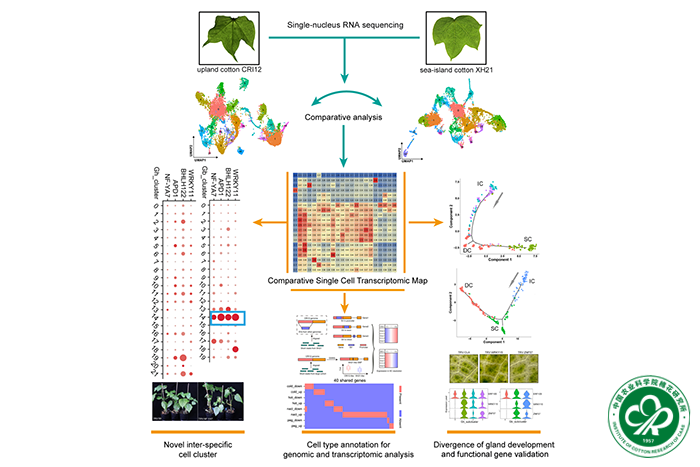- Location : Home» Newsroom
Comparative Single-Cell Transcriptomic Map Reveals Divergence in Leaves between Two Cotton Species at Cell Type Resolution
From: author: Count: 次 Date: 2025/10/286
Leaves are important functional organs in plants that determine yield and quality of crops. Upland cotton and sea-island cotton contribute more than 90% of the cotton fiber production annually. Deciphering and utilizing the diversity of leaf cells and functional genes underlying their divergences will be highly meaningful for cotton breeding.
To investigate the conserved and divergent cell types of leaves between upland cotton and sea-island cotton, identify functional genes, and explore functional cell types in response to biotic and abiotic stresses in both species.
Nuclei were isolated from leaves of upland cotton CRI12 and sea-island cotton XH21, respectively, and single-nucleus RNA-seq (snRNA-seq) was performed. Based on the orthologous genes, comparative single-cell transcriptomic map (CSCTM) of two cotton species was constructed to investigate conservation and divergence of cell types, and funtional genes were validated by virus induced gene silencing. Combining CSCTM, comparative genomic and transcriptomic analysis, functional cell types were identified in response to biotic and abiotic stresses.
A total of 22 and 20 distinct clusters were identified representing 6 main cell types in CRI12 and XH21, respectively. CSCTM analysis revealed a sea-island cotton-specific cell cluster, in which specifically expressed GbNF-YA7′s role in pathogen resistance was validated. Meanwhile, the divergence of pigment gland development was revealed among cotton species and WRKY15 was identified to influence gossypol content without affecting pigment gland number. Moreover, integrated CSCTM and comparative genomic and transcriptomic analysis revealed genome variations could influence the gene expression in an elaborate cell type-specifc manner, highlighted the function of cotton leaf vascular tissue cells in Verticillium wilt resistance and putative functional differentiation of conserved abiotic stresses response genes. Additionally, different cell types might assume distinct roles in dealing with various stresses, forming a complex stress response system.
This study uncovered the conservation and divergence in cell types of leaves of upland cotton and sea-island cotton, which will provide a better understanding of phenotypic variation of the two species.
